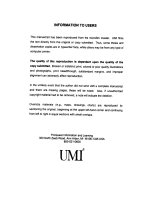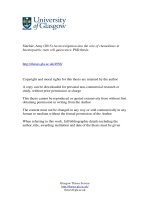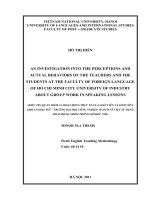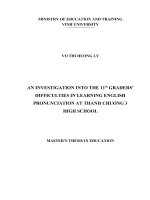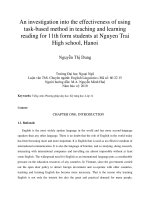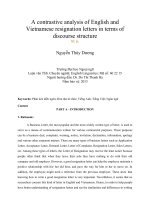An investigation into the social and emotional well being of gifted high school students in phan boi chau specialized high school = nghiên cứu về tình trạng cảm xúc của học sinh chuyên cấp 3 tại trường THPT chuyên phan bội châu
Bạn đang xem bản rút gọn của tài liệu. Xem và tải ngay bản đầy đủ của tài liệu tại đây (1.14 MB, 83 trang )
VIETNAM NATIONAL UNIVERSITY, HANOI
UNIVERSITY OF LANGUAGES AND INTERNATIONAL STUDIES
FACULTY OF ENGLISH LANGUAGE TEACHER EDUCATION
GRADUATION PAPER
AN INVESTIGATION INTO THE SOCIAL AND EMOTIONAL
WELL-BEING OF GIFTED HIGH SCHOOL STUDENTS IN PHAN BOI
CHAU SPECIALIZED HIGH SCHOOL
Supervisor:
Cao Thuy Hong (Ph. D)
Student:
Vo Thi Trang
Course:
QH2017.F1.E2
HA NOI – 2021
ĐẠI HỌC QUỐC GIA HÀ NỘI
TRƯỜNG ĐẠI HỌC NGOẠI NGỮ
KHOA SƯ PHẠM TIẾNG ANH
KHĨA LUẬN TỐT NGHIỆP
NGHIÊN CỨU VỀ TÌNH TRẠNG CẢM XÚC CỦA HỌC SINH CHUYÊN
CẤP 3 TẠI TRƯỜNG THPT CHUYÊN PHAN BỘI CHÂU
Giáo viên hướng dẫn:
TS. Cao Thúy Hồng
Sinh viên:
Võ Thị Trang
Khóa:
QH2017. F1.E2
HÀ NỘI – 2021
Signature of Approval
___________________________________________________________________
ACKNOWLEDGEMENTS
First and foremost, I would like to express my sincere gratitude for my
supervisor Dr. Cao Thuy Hong, teacher of Faculty of English Language Teacher
Education, ULIS-VNU. Without her comprehensive insight in the field of research,
patient guidance, enthusiastic encouragement as well as constructive critiques, I
would not have been able to finish this paper.
In addition, I would like to extend my appreciation to all students, and their
parents, as well as teachers at my former high school, Phan Boi Chau High School
for the gifted. Their unfailing support during the process of data collection helped to
reduce my expected burden in surveying in such a large scale.
Last but not least, I can never disregard significant support from the beloved
friends and my family for always being there, giving me great support and
encouragement, which motivated me to overcome all the obstacles along the way.
5
ABSTRACT
Social and emotional well-being (SEWB) is regarded as a fundamental
building block for the general development of all children (Colangelo & Davis, 2003;
Durlak, Dymnicki, Taylor, Weissberg & Schellinger, 2011; Peterson & Morris, 2010;
Schonert-Reichl & Hymel, 2007; Shechtman & Silektor, 2012; Silverman & Golon,
2008). Therefore, meeting their social and emotional needs has become an important
goal for education (Bridgeland et al., 2013; Weissberg et al., 2011). Gifted students
(GT) who demonstrate distinctive characteristics from their chronological age peers
may encounter unique social-emotional challenges which could hinder their personal
development, and thus may require unique support from their teachers and parents
(Peterson, 2009). With such significance highlighted, Vietnamese education,
nevertheless, appears to shy away from devoting attention to these special needs,
instead focusing purely on enhancing their cognitive abilities. Moreover, studies that
focus on SEWB of Vietnamese GT, especially those at high-school age are almost
undetectable. This study thus aimed at investigating SEWB of GT, through
perspectives of the GT, their parents and teachers. The quantitative approach was
employed whereby three groups of participants completed Strengths and Difficulties
Questionnaire (SDQ) to screen out the social emotional advantages and disadvantages
experienced by the GT. Findings from the study suggested that GT in the current study
possessed medium to high level of social and emotional strength; yet there remained
a number of unique issues relating to their social emotional difficulties. Among 4
types of difficulties investigated, hyperactivity problems were the most outstanding
challenges whereas conduct problems were least problematic. There were also some
noticeable discrepancies among different groups’ perceptions. First, peer
relationships were considered the most problematic by parents meanwhile they were
less aware by the other groups. Second, conduct difficulties were self-perceived with
a heightened degree by GT, yet seemed to be neglected by their parents and teachers.
Lastly, while GT and their parents shared the same opinion on the severity of
emotional challenges, these issues received lack of attention from the teachers.
6
These findings obviously contributed to the limited literature on GT, particularly
gifted high-school students in Vietnamese context. Besides, the mismatch between
GT’s, the teachers’ and parents’ perceptions towards SEWB of GT also has important
implications for further research and practices to support the social and emotional
well-being of GT.
Key words: Gifted students, social and emotional well-being
7
TABLE OF CONTENT
ACKNOWLEDGEMENTS ................................................................................................. 5
ABSTRACT........................................................................................................................... 6
TABLE OF CONTENT........................................................................................................ 8
LIST OF TABLES, FIGURES AND ABBREVIATIONS .............................................. 10
CHAPTER 1. INTRODUCTION ...................................................................................... 11
1.1.
Rationale of the study ........................................................................................... 11
1.2.
Research aims ....................................................................................................... 14
1.3.
Scope of the study ................................................................................................. 14
1.4.
Significance of the study....................................................................................... 15
1.5.
Organization of the study ...................................................................................... 15
CHAPTER 2. LITERATURE REVIEW .......................................................................... 17
2.1.
Giftedness ............................................................................................................. 17
2.2.
Students’ social-emotional well-being.................................................................. 24
2.1.1. Internal factors .................................................................................................... 25
2.1.2. External factor..................................................................................................... 30
CHAPTER 3. METHODOLOGY ..................................................................................... 32
3.1.
The setting............................................................................................................. 32
3.2.
Research design .................................................................................................... 33
3.3.
Participants and sampling ..................................................................................... 33
3.4.
Data collection instruments .................................................................................. 35
3.5
Translating and piloting the questionnaire ............................................................. 36
3.6. Data collection procedure ...................................... Error! Bookmark not defined.
3.7. Quantitative data analysis ...................................... Error! Bookmark not defined.
CHAPTER 4: FINDINGS AND DISCUSSION ............................................................... 42
4.1.
GT’s perception of their SEWB............................................................................ 42
4.2.
Teachers’ perception of GT’s SEWB ................................................................... 44
4.3.
Parents’ perception on GT’s SEWB ..................................................................... 46
4.4.
Comparisons on the SDQ among parent, teacher and GT groups ........................ 47
CHAPTER 5. DISCUSSION AND CONCLUSION ........................................................ 50
5.1.
Summary of the findings....................................................................................... 50
5.2.
Discussion ............................................................................................................. 50
5.3.
Conclusion and implications ................................................................................. 54
5.4.
Limitations and suggestions for further study ...................................................... 54
REFERENCES.................................................................................................................... 56
APPENDICES ..................................................................................................................... 72
8
1. Appendix A: Adapted Questionnaire for GT ................................................................ 72
2. Appendix B: Adapted Questionnaire for parents .......................................................... 76
3. Appendix C: Adapted Questionnaire for teachers ........................................................ 80
9
LIST OF TABLES, FIGURES AND ABBREVIATIONS
TABLE
Table 3.1. Subscales of the adapted SDQ ........................................................................... 36
Table 4.1. Cronbach’s α reliabilities of five sub-scales (students’ SDQ) ............................ 42
Table 4.2. Mean and Standard Deviation of GT’s SEWB (Students’ SDQ) ........................ 43
Table 4.3. Cronbach’s α reliabilities of five sub-scales (teachers’ SDQ) ........................... 44
Table 4.4. Mean and Standard Deviation of GT’s SEWB (teachers’ SDQ) ........................ 45
Table 4.5. Cronbach’s α reliabilities of five sub-scales (parents’ SDQ) ............................. 46
Table 4.6. Mean and Standard Deviation of GT’s SEWB (parents’ SDQ) .......................... 46
FIGURE
Figure 2.1. Renzulli's three-ring conception of giftedness (Renzulli, 1986) ........................ 18
Figure 2.2. Gardner’s model of Multiple Intelligences (1983, 2011) .................................. 20
Figure 2.3. Gagné's differentiated model of giftedness and talent (DMGT 2.0; 2008 update;
Gagné, 2010) ........................................................................................................................ 21
Figure 2.4. Steven Pfeiffer ‘s tripartite (pronounced try-par-tight) model of giftedness
(2012) .................................................................................................................................... 23
Figure 2.5. Internal and external factors impacting upon the SEWB of gifted children ..... 25
Figure 3.2. Demographic information of gifted students participants................................. 34
ABBREVIATION
GT
Gifted students
SEWB
Social and Emotional well-being
SQD
Strengths and Difficulties questionnaire
SPSS
IBM Statistical Package for the Social Sciences (SPSS) Version 23
10
CHAPTER 1. INTRODUCTION
This chapter outlines the need for research on the social-emotional well-being
(SEWB) of gifted students (GT) in specialized high schools in Vietnam. The research
questions that guided the study are also proposed together with the research aim and
scope. The chapter ends with expected contributions of the current study to future
research and practice in gifted education.
1.1.
Rationale of the study
The past few decades have witnessed an extraordinary growth in public
attention on improving the well-being of students. Although there appears to be a lack
of consensus on what constitutes well-being (Soutter & Gilmore, 2014), student wellbeing could be roughly classified into social, psychological, physical, and cognitive
well-being (Pollard &Lee, 2003). While the social dimension refers to relationships
with others, support, and interpersonal or communicative skills, the psychological one
is related to students’ emotions and mental health. Besides, the physical well-being is
displayed through the health and physical habits, and the the cognitive well-bing
depends on intellectual and school-related elements. Though all four types of wellbeing above are beneficial for the students in different ways, SEWB is perceived as
the most indispensable part in the general development of all children (SchonertReichl & Hymel, 2007; Silverman & Golon, 2008; Peterson & Morris, 2010; Durlak,
Dymnicki, Taylor, Weissberg & Schellinger, 2011; Shechtman & Silektor, 2012).
Specifically, Greene (2004) has suggested that SEWB is essential for
“…developing resilience, forming healthy relationships, improving academic
performance, coping with stressful life events, being successful and productive in the
workplace, learning thinking skills for problem-solving and decision making, and
infusing interest and challenge into the curriculum” (Greene, 2004, p. 31).
11
These skills would enable students to flourish in and out of school. According to the
Australian Institute of Health and Welfare (2012), children with high levels of SEWB
can possess significant personal identities such as self-confidence or self-reliance and
better strategies to deal with challenges and to succeed in life.
With its significance to students’ general well-being as well as future
development, SEWB should be an important goal for education (Bridgeland et al.,
2013; Weissberg et al., 2011). Fostering SEWB of students thus should be an
important task of any education system, including gifted education. However, in
comparison with the large body of research on SEWB of mainstream students,
research on SWEB of gifted students is somewhat limited (Coleman & Cross, 2014).
A possible assumption was that there were probably no differences between gifted
and non-gifted students in terms of SEWB (Nelihart et al., 2002).
However, current literature on gifted students appeared to suggest the
opposites. Despite higher academic intelligence, the SEWB of GT could be much
lower than that of non-gifted peers. They have the intellect to comprehend how
complex the world around them is while their emotional and social skills for their age
level could be limited (McGee et al., 2011; Rinn et al., 2010). They could also be
exposed to various social or emotional issues that other students may not have such
as problems in (a) initiating and maintaining relationships with others, (b) resolving
conflicts, (c) communicating feelings in appropriate and effective ways (Corso, 2007).
They have also been found to suffer from more serious issues such as: “trauma, career
development impasse and poor coping” (Peterson, 2009, p. 280). In short, GT as a
group may encounter unique social-emotional challenges related to their giftedness
which could hinder their personal development and may require differentiated support
from their teachers and parents. In other words, SEWB’s important role in gifted
education cannot be neglected.
12
Though in some foreign countries, maintaining and improving SEWB of GT
is one of the utmost objectives of their curriculums, Vietnamese educational system
seems to shy away from devoting attention to these factors, instead focusing purely
on enhancing their cognitive abilities. In Vietnam, the educational curriculums are
built around the students’ ability to memorize knowledge, and the school workload is
considerable, which makes it hard for students to acquire all the knowledge within
school time and they have to use private tutors as a necessity (Dang, 2011; Phu, 2013).
Moreover, the gifted have to bear the additional pressure of achieving and maintaining
high level of academic performance and being well prepared for a variety of
examinations including the national high school exam or even National and
International Talented Students competitions. It is not only owing to the importance
of outstanding academic achievement with their future but also because high studying
results can help to raise the family reputation and social position (Huy, 2012; Thai &
Falaris, 2014). Because of that significance, Vietnamese GT students’ SEWB tend to
be overlooked, which potentially poses negative impacts on their mental health
(Hoang, Minh & Tu, 2009). A study conducted by Thuy (2011) revealed that 82.90%
of senior students in specialized high schools in Hanoi experienced stress at different
levels. In another research on stress faced by Vietnamese Gifted students, Nguyen,
Hoang and Nong (2015) also found that 74.00% of Vietnamese GT students were
experiencing mild to medium stress levels. Pupils living away from home were found
to experience a higher level of stress compared to those who had close physical
connections with their mom and dad. It can be inferred that both academic pressure
and lack of parental support can exaggerate mental problems facing by GT learners in
our country.
Up to present, much of the research literature has focused on the academic
needs of GT (Davis & Rimm, 2004; Garvis, 2014; Gross, 2004), yet little has been
known about the SEWB of GT, especially the gifted adolescents. With regard to the
Vietnamese context, very few empirical studies have already shed light on this topic.
13
Such a lack of emphasis placed on this research topic has motivated me to conduct an
in-depth exploration on the SEWB of GT in a Vietnamese High School.
1.2.
Research aims
The purpose of this study is to investigate the social and emotional strengths
and weakness of GT through the perspectives of GT, their teacher and parents. Such
a multi-perspective approach would hopefully help bring about a more thorough
understanding of GT’s SEWB.
To achieve this aim, the following research questions are put forward:
a) What is GT's perception of their own SEWB?
b) What is GT's SEWB as perceived by their teachers?
c) What is GT's SEWB as perceived by their parents?
d) Are there any differences between GT's perception of their SEWB and that of
their teachers' and parents'?
1.3.
Scope of the study
Being gifted does not mean an all-encompassing quality, excelling at all
aspects but rather a potential to perform outstandingly in one or more functioning
areas compared to others of the same age, experience or within a particular
environment (Gagné, 2008). Therefore, it is important to note that the present study
only focuses on the group of adolescents who have been identified as academically
gifted and are attending gifted high schools. This identification is based on the model
of Pfeiffer (2012) which is presented in chapter 2.
This research was conducted among students, teachers and parents at Phan Boi
Chau high school for the Gifted in Nghe An, a province in the Middle of Vietnam.
This site is the former high school of the researcher and it is also located in the
14
researcher’s hometown. Within the scope of the current study (a BA thesis), this
context is suitable, manageable, and convenient for recruiting participants and
collecting data. Participants included 1300 GT from 39 classes, 1300 parents and 39
form teachers working with these students.
1.4.
Significance of the study
The study has both theoretical and practical significance. To begin with, it
attempts to provide a better understanding of the Vietnamese high school gifted
students’ SEWB in relation to international research. As mentioned above, SEWB of
GT in Vietnam has not yet received careful attention and that their social and
emotional needs seem to be neglected compared to academic needs has been frankly
admitted by policy makers and educators in many governmental conferences (Huu,
2018). The research is expected to explore the level of Vietnamese GT’ SEWB, which
has hardly been concerned by empirical research particularly within Vietnam. This,
therefore, can fill in the identified gap in the literature on the SEWB of high school
GT in Vietnamese context.
Besides, once disprepancies in perceptions of GT, their teacher and parents
towards GT’ SEWB are revealed, it may help the teachers, educators, schools and
parents to have profound insights into the most predominant difficulties experienced
by GT, develop practical strategies to support these students socially and emotionally.
Thanks to this, GT can have favorable conditions to reach their full potential and
flourish.
1.5.
Organization of the study
This research consists of five chapters, among which the first one –
“Introduction” identifies the gaps related to the SEWB of GT focusing on the context
of Vietnam, which serves as the rationales for conducting the study. Research aim and
scope are also identified before research questions are stated and the expected
significance are presented. Chapter 2 – “Literature review” provides a general
15
picture on how “Giftedness” and “Social and Emotional well-being” are
conceptualised and investigated throughout history, then decides on the suitable
frameworks for the current study. Chapter 3 - “Methodology” presents the research
design, instruments, procedure of sampling, data collection and data analysis process.
The researcher first describes these processes and later explains why particular
methods were chosen and how they were carried out. Chapter 4 - Findings and
Discussion presents the key findings of the research, furnishing evidence for the
research question. The final chapter – “Conclusion” briefly sums up the key
findings and furthers the discussion on the topic. Some implications are aslo deduced
from the results before the researcher acknowledges the limitation of this study and
makes suggestion for future studies.
16
CHAPTER 2. LITERATURE REVIEW
This chapter clarifies two central concepts of this study, namely giftedness and socialemotional well-being (SEWB) of the gifted by reviewing relevant theoretical
frameworks. Though definitions may vary among research, giftedness, in this study,
is conceptualised based on the model of giftedness proposed by Steven Pfeiffer in
2012. Besides, the concept of SEWB is explored through Hamilton and Redmond’s
(2010) model, which views gifted student (GT)’s SEWB as the result of both
individual and environmental factors. Moreover, GT’s social and emotional
experiences which are affected by both internal and external factors are also critically
reviewed.
2.1.
Giftedness
The concept of giftedness has widely been discussed throughout history, yet
up to now there is no consensus existing on how it should be conceptualized. It was
first defined by Terman (1926) as “the top one percent level in general intellectual
ability as measured by the Stanford-Binet Intelligence Scale or a comparable
instrument” (p. 43). This was later supported by the theory of Robinson, Ziegler, and
Gallagher (2000), which viewed giftedness as a generic, innate quality of an
individual that might be assessed through some type of cognitive or IQ testing.
However, rather than focusing solely on intellectual ability, other developmental
theories started to acknowledge that the giftedness should be recognized in a broader
scale (Gardner, 1983; Sternberg & Grigorenko, 2002; Subotnik, Olszewski-Kubilius,
& Worrell, 2011). Gagnè (2005), for example, defined giftedness as the children’s
natural special abilities, which then has the potential to develop into outstanding
talents in specific fields. Pfeiffer (2012) also regarded gifted students as those
demonstrating the ability or potential ability to perform extraordinarily in many fields.
While there were some disagreements as well as overlaps among theories, it is
important to note that the concept of giftedness is dependent upon time, place and
cultural contexts and being reinforced by social values (McAlpine, 2004). While there
17
have been many theoretical models of giftedness and talent development, three
following models are among the most popular ones used by researchers.
2.1.1. Renzulli’s Three Ring Conception of Giftedness (1986)
The three-ring conception of giftedness is a portrayal of the main dimensions
reflecting the potential of the gifted human. Regarding intellectual domains, Renzulli
(1986) stated that gifted students are often characterized with high ability, high
creativity, and high task commitment. Figure 2.1 illustrates the model with 3 rings
representing factors influencing the productivity of gifted behaviors, namely (1) task
commitment (including determination, will power, perseverance or the positive
energy of people on a particular task or performance area), (2) creativity (including
curiosity, originality, ingenuity, and a willingness to challenge convention and
tradition)(Renzulli, 2012; Renzulli & Gaesser, 2015) and (3) above average ability
(i.e., the ability to perform in the top 10% of any given domain). These 3 rings are
embedded in the houndstooth pattern in the background, which represents
environmental factors that also give rise to Gifted behaviors (Renzulli, 2002). The
interaction between basic clusters of three human traits can make a contribution to the
development of the Gifted.
Figure 2.1. Renzulli's three-ring conception of giftedness (Renzulli, 1986)
Renzulli’s (1986) conception of giftedness proposes a general identification
of the GT, which is not based on academic performance only, but also dependent
18
upon other factors. For example, one student with not very high examination scores
could also be perceived as a GT if he/ she has highly developed special interests or
outstanding potentialities in other areas such as art and social leadership; or if he/
she is intrinsically motivated.
However, one of the shortcomings of this model is when identifying students
with above average ability and creativity, this model fails to find a field or area of
interest that they are good at (Chaffey, 2004). Thus, there is not enough needed
motivation and stimuli to trigger their gifts, leading to their lack of task commitment
. Therefore, the identification of giftedness following this theory should be supported
by other models so that the results would be more synthetic.
2.1.2. Gardner’s Theory of Multiple Intelligences (1983, 2011)
Gardner (1983) framed giftedness as individuals’ innate special abilities, which
can be developed and sharpened throughout the time. He initially proposed seven
types of intelligences namely linguistic, musical, logical-mathematical, spatial,
bodily-kinesthetic, interpersonal, and intrapersonal intelligence. This list was later
extended with the addition of naturalist intelligence and the discussion of spiritual and
existential intelligence in 2011 (see Figure 2.2). Following the theory, the term
“giftedness” is related to specific intelligences which are defined as the ability, talent
or skill enabling people to demonstrate their particular strength in specific fields.
19
Figure 2.2. Gardner’s model of Multiple Intelligences (1983, 2011)
Gardner’s (1983) multiple intelligences are beneficial for identifying and
enhancing a child’s areas of strength. Hoerr (1994) complimented this theory on
offering much to the dialogue on the nature of giftedness. For instance, it was adopted
as a framework for the identification (Hernández-Torano, Prieto, Ferrándiz, Bermejo,
& Sáinz, 2013; Kuo, Maker, Su, & Hu, 2010) and education (Callahan, Tomlinson,
Moon, Tomchin, & Plucker, 1995; Carpintero, Cabezas, & Sánchez, 2009) of highability students in many different countries.
However, the opponents of this model argued that it not especially suitable for
meeting the needs of gifted students. Le Sueur (2002) stated that gifted students have
special needs that must be recognized, valued and catered for. The teaching strategies
and approaches that seem to be suitable for students with different types of
intelligence fail to meet unique needs of those who are gifted or talented. Besides, it
is stated that multiple intelligences can derive from genetic inheritance or be
developed through training, environmental opportunities, and socialization, thus they
are considered to be autonomous (Gardner, 1983, 2011). This autonomy of multiple
intelligences is strongly criticized as it may be inconsistent with the prevailing theory
of general intelligence (Geake, 2008). Therefore, as with Renzulli’s (1986) model of
giftedness, Garder’s theory must form a part of an educator’s overall understanding
about the principles of gifted education and is best used in conjunction with other
models.
2.1.3. Gagné’s Differentiated Model of Giftedness and Talent (2005, 2008)
The model of Gagné is a developmental model of giftedness that serves to
distinguish giftedness and talent. “Giftedness”, in this case, is constituted by a child’s
natural abilities in one or more domains while “talent” is regarded as “developed
abilities or high performance” and it is developed enhanced through the intervention
of catalysts and other influences (Gagné, 2005). This differentiation indicates that
20
students owning unique abilities which has not been manifested yet are still labeled
as the gifted.
Figure 2.3. Gagné's differentiated model of giftedness and talent (DMGT 2.0; 2008
update; Gagné, 2010)
As could be observed in figure 2.3, giftedness is the potential or aptitude in at
least one area of mental functioning (including intellectual, creative, social and
perceptual) or physical ability (including muscular and motor control) within an
individual. This then will pass through a developmental process and be sharpened into
talent by the interaction of environmental and intrapersonal factors. The talent, over
time, can be shaped in various fields namely academic, technical, science and
technology, arts, social service, administration/ sales, business operations or games,
and athletics and sport. Specifically, the talent development requires systematic
activities, progress and a source of investment, without which the untrained cannot
develop into particular skills or talents. Supposed a child is considered as gifted, his/
her performance level in developed competencies should be within the top 10% when
compared to their peers having the same learning in the given task.
The model of Gagné’s, is regarded as the extension or development of
Renzulli’s (1986) Three ring model of giftedness. The differentiation of two term
21
“giftedness” and “talented” manages to fulfill the gap of Renzulli’s model that
mentions task commitment as one important trait of giftedness. Borland (1989)
recognized the value of that distinction and he stated: “Gagne’s use of the terms
giftedness and talent appears to be the least arbitrary and the most useful of those
proposed thus far. The distinction between competence and performance is a real and
meaningful one, and it allows for the building of a model that permits the
operationalization of the concepts” (p. 23). With unnoticeable limitation, this model
is evidently applied in gifted education policies around the world, especially in
Western countries. However, its application in Vietnamese context appears to be
negligible due to the existence of social norm throughout history towards gifted
students (Tran, 2014). While the way giftedness is identified in Western nations is
broad and flexible, giftednesss in Vietnam is only recognized only when students
perform really outstandingly at school and normally decided based on the test results
on the specialized subjects, which was also regulated by Vietnamese Ministry of
Education and Training in 2012.
2.1.4. Steven Pfeiffer ‘s tripartite (pronounced try-par-tight) model of giftedness
(2012)
According to Steven Pfeiffer (2012), a gifted child is one who “demonstrates a
greater likelihood, when compared to other students of the same age, experience, and
opportunity, to achieve extraordinary accomplishments in one or more culturally
valued domains” (2012, p. 14).
The model of Pfeiffer provides a nuanced and inclusive definition of
giftedness, in which this term is viewed under three “distinct but complimentary
lenses” (Pfeiffer, 2012, p. 8):
(1). High intelligence, or;
(2). Outstanding accomplishments, or;
22
(3). High potential to excel.
Figure 2.4. Steven Pfeiffer ‘s tripartite (pronounced try-par-tight) model of
giftedness (2012)
Following this model, each lens is an independent definition of giftedness, and
unlike Renzulli’s (1986) Three ring conception of giftedness, an individual only has
to fit into a single category. The first category refers to the learners with exceptionally
high intelligence. These students are usually ranked at the top of the tests at school
(Pfeiffer, 2012) and easily identified due to their early development of speech and
reading (Gross, 1993). The second category describes gifted learners with aboveaverage academic performance. Their desire for learning, and willingness to confront
challenges along with their good academic ability are the things distinguishing them
from their peers (Pfeiffer, 2012). The last category defines gifted children with high
potential to excel. These students stand out with their burning curiosity about new
things and their hard work in learning. Despite not being included in the top
23
percentiles of the class’s testing, they demonstrate the potential to excel once they
have necessary tools.
The tripartite model is at once both comprehensive and simple. Among the
three domains, academically gifted learners may be the best fit for the way
Vietnamese people identify “giftedness”. As noted in the Regulation of Organization
and Operation of Gifted High Schools (Ministry of Education and Training, 2012),
students are recruited into schools for the gifted based on test results of three general
subjects including English, Vietnamese literature, and Mathematics as well as the test
score of the specialized subject. The score of the major area is doubled before being
added to those of the other three tests to find out the accumulative scores, which helps
to decide suitable candidates to attend school (Ministry of Education and Training,
2012). In other words, in order to be accepted into the program for GT, students have
to perform outstandingly in different academic tests, which matches with the
identification of academically gifted learners proposed by Pfeiffer (2012). Unlike the
model of Gagné (2005) in which students owning unique abilities that have not been
manifested yet are still labeled as the Gifted, the model of Pfeiffer (2012) provides a
more inclusive answer to identify giftedness based on academic performance. Bearing
some similarities in the way gifted children are normally labeled in Vietnam, the
definition of Pfeiffer (2012) is therefore chosen to define GT within the current study.
2.2.
Students’ social-emotional well-being
The concept of “well-being” was widely conceptualized by a variety of models
throughout history. These conceptions, though may bear some differences in the way
of defining the subject, share the same idea that “well-being” is a sophisticated and
multi-dimensional construct that cannot be solely measured by a factor in a single
domain (Borgonovi & Pál, 2016). As defined succinctly by the World Health
Organization (2014), well-being is “a state of well-being in which an individual
realizes his or her own abilities, can cope with the normal stresses of daily life, can
work productively and is able to make a contribution to his or her community” (p.1).
24
SEWB is just a part in the big picture of well-being. It is viewed as “the way
a person thinks and feels about themselves and others”, and their resilience and
coping skills in dealing with daily challenges (Australian Institute of Health and
Welfare, 2012, p. 8).
Hamilton and Redmond (2010) suggested that the level of SEWB is affected
by 2 separate, yet interrelated domains: internal and external factors.
Figure 2.5. Internal and external factors impacting upon the SEWB of gifted
children
As shown in figure 2.5, factors arising internally are as a result of the
characteristics of giftedness (including asynchronous development, feeling different,
highly perceptive, self-expectation and perfectionism, and relationships with peers).
In contrast, external factors arise due to the gifted child’s interaction with the
environment (comprising understanding of worth through external expectation, and
educational conformity).
As this model evaluates SEWB based on the impacts of individual and
environmental factors, it is necessary to dig deeper into the GT’s experiences that are
related to these domains.
2.1.1. Internal factors
25
